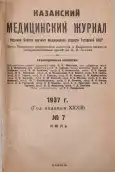Antiseptic (cold) glove processing experience
- Authors: Dembskaya I.G.1
-
Affiliations:
- Tobolsk Regional Hospital
- Issue: Vol 33, No 7 (1937)
- Pages: 870-876
- Section: Articles
- URL: https://bakhtiniada.ru/kazanmedj/article/view/74778
- DOI: https://doi.org/10.17816/kazmj74778
- ID: 74778
Cite item
Full Text
Abstract
The issues of disinfection of the surgeon's hands are still not fully resolved. Despite the desire of surgeons to reduce the number of suppurations, the percentage of suppuration after clean operations is still quite high, and in some surgeons it reaches 15 and even higher. It is clear that many factors causing suppuration do not depend on the hands of the surgeon, but the treatment of the hands, undoubtedly, plays the most important role. There are many ways to handle hands. Of these, mechano-chemical (Furbringer, Spasokukotsky, Alfeld, Mikulich) and tanning (Zabludovsky, Pokotilo, Geisner, Gerf, etc.). However, as proved bacteriologically, neither the action of chemicals nor mechanical means can achieve durable and long-term sterilization of hands. I remember how Professor VL Bogolyubov, at one of his lectures to students, ironically said that “hands could be considered sterile only after boiling them for 20 minutes in a 2% soda solution.” It is quite understandable why many surgeons have been for about 40 years. back they tried to operate only with sterilized gloves. Now bacteriologically proven that the best way to reduce postoperative suppuration is to operate with sterilized gloves. Regarding this, Prof. Gubarev writes: “You cannot wash your hands so that they are sterile, but gloves can be sterilized as you like".
Keywords
Full Text
##article.viewOnOriginalSite##About the authors
I. G. Dembskaya
Tobolsk Regional Hospital
Author for correspondence.
Email: info@eco-vector.com
Surgery department
Russian Federation, TobolskReferences
Supplementary files






